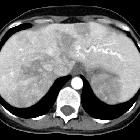blue rubber bleb nevus syndrome





Blue rubber bleb nevus syndrome (BRBNS) or Bean syndrome, is a rare sporadic syndrome characterized by multifocal venous anomalies. Patients often have multiple soft blue skin lesions (blueberry muffin syndrome) associated with multiple bowel venous malformations, which could lead to lower gastrointestinal bleeding.
Pathology
The skin and gastrointestinal tract are the primary sites of involvement. Multiple other organ systems can be affected, including the musculoskeletal system, vulva, submandibular region, parotid region, thymus, masticator space, and cranium (sinus pericranii). There are rare reports of involvement of the orbits, thyroid, heart, pericardium, lungs, peritoneal cavity, adrenal glands, and kidneys .
Differential diagnosis
- hereditary hemorrhagic telangiectasia
- multiple telangiectasias, pulmonary arteriovenous malformations
- epistaxis
- hereditary, positive family history
- Maffucci syndrome
- multiple enchondromas
- Klippel-Trénaunay syndrome
- port wine stain capillary hemangiomas
- varicosities
- localized gigantism
History and etymology
The association of “hemangiomas” of the skin and gastrointestinal tract was first reported in 1860 by Gascoyen. The condition was fully characterized by, the American physician and polymath William "Bill" Bennet Bean (1909-1989) in 1958 .
See also
Siehe auch:
- Morbus Osler-Weber-Rendu
- durale AV-Fistel
- untere gastrointestinale Blutung
- Maffucci-Syndrom
- Klippel-Trénaunay-Weber-Syndrom
- zerebrale venöse Malformationen
und weiter:

 Assoziationen und Differentialdiagnosen zu Blue-rubber-bleb-naevus-Syndrom:
Assoziationen und Differentialdiagnosen zu Blue-rubber-bleb-naevus-Syndrom:




